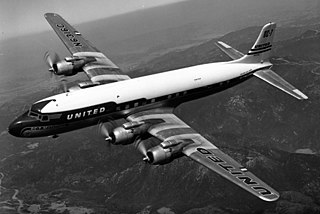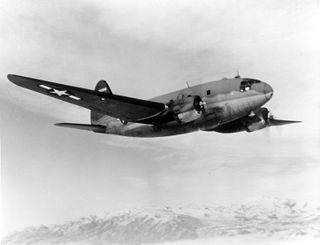
An aviation accident is defined by the Convention on International Civil Aviation Annex 13 as an occurrence associated with the operation of an aircraft, which takes place from the time any person boards the aircraft with the intention of flight until all such persons have disembarked, and in which (a) a person is fatally or seriously injured, (b) the aircraft sustains significant damage or structural failure, or (c) the aircraft goes missing or becomes completely inaccessible. Annex 13 defines an aviation incident as an occurrence, other than an accident, associated with the operation of an aircraft that affects or could affect the safety of operation.

Delta Air Lines Flight 1141 was a scheduled domestic passenger flight between Dallas/Fort Worth, Texas and Salt Lake City, Utah. On August 31, 1988, the flight, using a Boeing 727-200 series aircraft, crashed during takeoff, resulting in 14 deaths and 76 injuries of the 108 on board.

The Douglas DC-7 is an American transport aircraft built by the Douglas Aircraft Company from 1953 to 1958. A derivative of the DC-6, it was the last major piston engine-powered transport made by Douglas, being developed shortly after the earliest jet airliner—the de Havilland Comet—entered service and only a few years before the jet-powered Douglas DC-8 first flew in 1958. Unlike other aircraft in Douglas's line of propeller-driven aircraft, no examples remain in service in the present day, as compared to the far more successful DC-3 and DC-6.

The McDonnell Douglas DC-9 is an American five-abreast, single-aisle aircraft designed by the Douglas Aircraft Company. It was initially produced as the Douglas DC-9 prior to August 1967, after which point the company had merged with McDonnell Aircraft to become McDonnell Douglas. Following the introduction of its first jetliner, the high capacity DC-8, in 1959, Douglas was interested in producing an aircraft suited to smaller routes. As early as 1958, design studies were conducted; approval for the DC-9, a smaller all-new jetliner, came on April 8, 1963. The DC-9-10 first flew on February 25, 1965, and gained its type certificate on November 23, to enter service with Delta Air Lines on December 8.

United Airlines Flight 823 was a scheduled flight from Philadelphia International Airport, Pennsylvania, to Huntsville International Airport, Alabama, with 39 on board. On July 9, 1964, around 18:15 EST, the aircraft, a Vickers Viscount 745D, registration N7405, crashed 2.25 mi (3.62 km) northeast of Parrottsville, Tennessee, after experiencing an uncontrollable fire on board, killing all 39. The fire of unknown origin occurred in the passenger cabin. One passenger abandoned the aircraft through the No.4 escape window prior to impact, but did not survive the free-fall. Among the victims was Durant da Ponte, professor of American literature and assistant dean of the University of Tennessee graduate school.

Northeast Airlines was an American airline based in Boston, Massachusetts that chiefly operated in the northeastern United States, and later to Canada, Florida, the Bahamas, Los Angeles and other cities. It was acquired by and merged into Delta Air Lines in August 1972.

Northeast Airlines Flight 946 was a domestic U.S. flight from Boston, Massachusetts, to Montpelier, Vermont, with a scheduled stop in Lebanon, New Hampshire, operated by Northeast Airlines. On October 25, 1968, some time during the evening, the Fairchild Hiller FH-227 aircraft crashed on Moose Mountain while descending on approach. The crash killed 32 of 42 passengers and crew. Of the fatalities, four were employees from the National Life Insurance Company who were returning from a business trip. The fatalities also included a reporter for the Barre Daily Times and six social workers of the Vermont Head Start Supplementary Training Program on a conference trip. Ten passengers survived the crash with minor or moderate injuries. After the crash, Northeast Airlines continued flight service until its merger with Delta Air Lines in the early 1970s.

Eastern Air Lines Flight 375, registration N5533, was a Lockheed L-188 Electra aircraft that crashed on takeoff from Logan International Airport in Boston, Massachusetts, on October 4, 1960. Ten survived, nine with serious injuries, but 62 of 72 on board were killed in the accident.

Continental Charters Flight 44-2, a domestic non scheduled passenger flight from Miami, Florida to Buffalo, New York, crashed on December 29, 1951 near Napoli, New York. The twin engine C-46 Commando, registration N3944C, crashed approximately 10:25 pm in adverse weather conditions. Of the four crew and 36 passengers on board, three crew members and 23 passengers perished. The flight crew's poor judgment in attempting a flight by visual reference during instrument weather conditions was the cause of the accident.
In aeronautics, loss of control (LOC) is the unintended departure of an aircraft from controlled flight, and is a significant factor in several aviation accidents worldwide. In 2015 was the leading cause of general aviation accidents. Loss of control may be the result of mechanical failure, external disturbances, aircraft upset conditions, or inappropriate crew actions or responses.

Associated Aviation Flight 361 was a domestic charter flight operated by Associated Aviation that on 3 October 2013 crashed on takeoff from Lagos, Nigeria, killing 16 of the 20 people on board. The aircraft, a twin turboprop Embraer 120 Brasilia, was transporting the body of Nigerian politician Olusegun Agagu to Akure, Nigeria, for burial.

Delta Air Lines Flight 1288 was a regularly scheduled flight from Pensacola, Florida to Atlanta, Georgia. On July 6, 1996, the aircraft serving the flight, a McDonnell Douglas MD-88, was on takeoff roll from Runway 17 at Pensacola when it experienced an uncontained, catastrophic turbine engine failure that caused debris from the front compressor hub of the left engine to penetrate the left aft fuselage. The cause of the engine failure was found to have been a fault in the manufacture of the fan. The failure of the airline to spot the resulting crack in the blade was a contributing factor.











